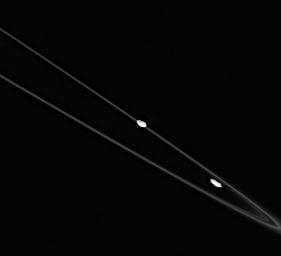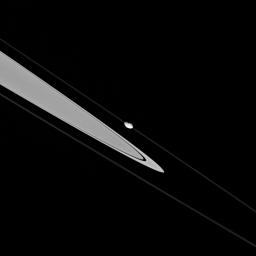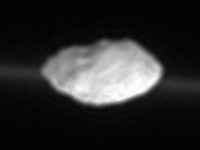Small Moons On A String |

  |
Small Moons On A String |
 Dec 15 2005, 04:06 PM Dec 15 2005, 04:06 PM
Post
#1
|
|
 Member    Group: Members Posts: 531 Joined: 24-August 05 Member No.: 471 |
PIA07653: Close to the Shepherd Moons
http://photojournal.jpl.nasa.gov/catalog/PIA07653 10/29/05 - 459,000 km from Pandora:  PIA07647: Pandora on a String http://photojournal.jpl.nasa.gov/catalog/PIA07647 10/29/05 - 455,000 km from Pandora:  More moons on Saturns string? -------------------- - blue_scape / Nico -
|
|
|
|
 Dec 15 2005, 10:34 PM Dec 15 2005, 10:34 PM
Post
#2
|
||
|
Solar System Cartographer     Group: Members Posts: 10146 Joined: 5-April 05 From: Canada Member No.: 227 |
The one with two moons was Cassini's picture of the day on Dec. 15. Unfortunately they misidentified the moons - the most elongated one is Prometheus, they reversed the names by mistake, in the press release. Maybe it will be corrected (Jason?)
And here I've made a composite of the whole set of images of Prometheus from that sequence. Three times enlarged, and merged to reduce jpg artifacts. This is similar in orientation to the best Voyager view. Phil -------------------- ... because the Solar System ain't gonna map itself.
Also to be found posting similar content on https://mastodon.social/@PhilStooke NOTE: everything created by me which I post on UMSF is considered to be in the public domain (NOT CC, public domain) |
|
|
|
||
 Dec 16 2005, 12:53 PM Dec 16 2005, 12:53 PM
Post
#3
|
||
|
Junior Member   Group: Members Posts: 76 Joined: 19-October 05 Member No.: 532 |
QUOTE (Phil Stooke @ Dec 15 2005, 11:34 PM) The one with two moons was Cassini's picture of the day on Dec. 15. Unfortunately they misidentified the moons - the most elongated one is Prometheus, they reversed the names by mistake, in the press release. Maybe it will be corrected (Jason?) And here I've made a composite of the whole set of images of Prometheus from that sequence. Three times enlarged, and merged to reduce jpg artifacts. This is similar in orientation to the best Voyager view. Phil The release on The JPL webpage is usually identical to the one on the ISS team page. Oddly enough in this case they are (now?) different. The text on the ISS team page correctly identifies the satellites. Cassini Project: http://saturn.jpl.nasa.gov/multimedia/imag...fm?imageID=1903 ISS Team: http://ciclops.org/view.php?id=1649 |
|
|
|
||
 Dec 16 2005, 07:02 PM Dec 16 2005, 07:02 PM
Post
#4
|
|
|
Solar System Cartographer     Group: Members Posts: 10146 Joined: 5-April 05 From: Canada Member No.: 227 |
Here's the companion image of Pandora. These are both the trailing sides. This is opposite the side of Pandora seen best by Voyager. It is 3 times enlarged, and a composite of seven images to subdue JPG artifacts.
Phil 
-------------------- ... because the Solar System ain't gonna map itself.
Also to be found posting similar content on https://mastodon.social/@PhilStooke NOTE: everything created by me which I post on UMSF is considered to be in the public domain (NOT CC, public domain) |
|
|
|
  |

|
Lo-Fi Version | Time is now: 19th April 2024 - 02:53 AM |
|
RULES AND GUIDELINES Please read the Forum Rules and Guidelines before posting. IMAGE COPYRIGHT |
OPINIONS AND MODERATION Opinions expressed on UnmannedSpaceflight.com are those of the individual posters and do not necessarily reflect the opinions of UnmannedSpaceflight.com or The Planetary Society. The all-volunteer UnmannedSpaceflight.com moderation team is wholly independent of The Planetary Society. The Planetary Society has no influence over decisions made by the UnmannedSpaceflight.com moderators. |
SUPPORT THE FORUM Unmannedspaceflight.com is funded by the Planetary Society. Please consider supporting our work and many other projects by donating to the Society or becoming a member. |

|